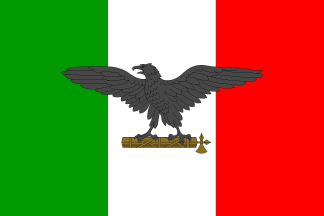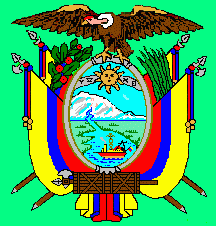 image by Mario Fabretto, 14 November 1998
image by Mario Fabretto, 14 November 1998

Last modified: 2014-08-23 by rob raeside
Keywords: fasces |
Links: FOTW homepage |
search |
disclaimer and copyright |
write us |
mirrors
 image by Mario Fabretto, 14 November 1998
image by Mario Fabretto, 14 November 1998
The flag of the Repubblica Sociale Italiana features the fasces with an eagle.
 image by Bonn Robert 20 January 1999
image by Bonn Robert 20 January 1999
Mussolini's personal flag also used fasces.
Today I got as change an old "liberty head" US dime, dated 1924. On the reverse is the fasces, the ancient symbol of authority in the Roman Republic. A bundle of sticks bound together represent the idea that while one stick breaks easily, a bundle will not, while an axe in the middle represents military strength. There are fasces on the walls of the US House of Representatives.
Meanwhile, the Fasces also became associated with Fascism in Italy and Germany, around the time that this dime was issued. Does anyone know when the fasces came off the dime and if it was related to the rise of fascism in Europe?
The only flag I know to have fasces for sure is Italian-occupied Albania.
Joshua Fruhlinger 14 Nov 1996
Before the rise of fascism fasces were usually conected with the idea of republicanism, and still are. The extensive use of fasces in many places were especially in art stylo of 'secesionism' (at least that it is called here, beggining of 20th century, and art historian on the list would know what I am talking about and give proper English name).
In that time fasces were to be find often as decorative element on furniture and fasades of buildings. Of the flags displaing them, three commes to mind off hand:
personal standard of Mussolini - blue with golden orle and fasces
Ecuador, state flag, in lower part of coat of arms.

![[Flag of Sankt Gallen]](../images/c/ch-sg.gif)
Military Flag of Switzerland c.1800 showing Willam Tell near fasces.

Željko Heimer,Jan Oskar Engene, Ivan Sache, Jean François Blanc, Philippe Bondurand, 6 March 1998
1821 flags and arms of Gran Colombia used fasces in the arms (see also this page)
 image by Jaume Ollé, 4 October 2001
image by Jaume Ollé, 4 October 2001
Željko, I think, has mentioned the fasces in Ecuador's arms - this is not surprising as the Latin American states, like the US itself, were very influenced by neo-classicalism for their national iconographies.
Fasces can also be found lurking behind the shield of the arms of Cuba, believe it or not, and as the national arms appear on the Presidential standard, Fidel Castro himself bears fasces!
I have been lead to believe that the term "Fascism" comes only indirectly from the Roman usage (though no doubt Mussolini was not adverse to asserting the link) and that it stems from the "fasci di combattimento" "combat squads" formed immedately after WW1 by disenchanted veterans which Mussolini organised into a national movement which swept him to power. I don't know if this is strictly correct though.
Roy Stilling, Tue, 19 Nov 1996
A fasces refers to a bundle of rods wrapped together with an axe. It was used during the Roman Empire.
In terms of modern political usage, I know of the following few examples (aside from the obvious case of Italy) :
During the time of Marshal Philippe Petain's rule, the symbol of his regime was a double-edged fasces. I am not sure what the Party symbol of Jacques Doriot's Parti Populaire Francais (PPF) was, but I believe that the PPF might have used this symbol as well. I am not sure if Sir Oswald Mosley's British Union of Fascists (BUF) used the fasces in its iconography. (I believe the BUF main symbol was a lightning flash).
I am unsure if the Italian flag and iconography was changed at all during the time of the Italian Social Republic (Salo Republic).
severus <severus@ix.netcom.com>
Tue, 19 Nov 1996
The Parti Populaire Francais was founded in 1934. According to David Littleton's _Foreign Legions of the Third Reich, Vol. 1: Norway, Denmark,France_, San Jose, California, 1979), the PPF had two emblems. First a red octagon bordered in blue with the party initials (interlaced) in white on the red field. This was used on the party flag, which consisted of a white saltire, upper and lower fields in red, hoist and fly parts in blue, and with the octagon shaped emblem in the intersection of the arms of the saltire. This emblem was replaced by an emblem consisting of a stylized francisque (sometimes surrounded by a cog wheel). It was used on the flag of the Gardes Francaises of the PPF, identical to the party flag except for the emblem in the centre. Both flags had gold fringes.
Jan Oskar Engene 20 Nov 1996
I have found the following text in Hella S. Haase's book 'The gardens of Bomarzo' (see more on the book and its author below).
"The attributes of [Roman] kingship, i.e. the golden crown, the throne and the scepter, are of Etruscan origin. Similarly, the fasces , i.e. the assembling of birch tied around a double-bladed axe, symbol of authority as imperium , the sacred absolute power of the king, originated from Etruria ; the oldest known fasces were found in Vetulonia inside a tomb dated c. 600 BC. The influence of the eastern mediterranean areas is nearly ascertained. The double or even tripled-bladed axe, the labris , had been for several centuries a religious symbol in Crete ; the palace of the legendary king Minos was called the Axe House, or Lagyrinth. The blade had the shape of a moon crescent. There are some who claim that the axe as a weapon originated from the Dorian oppressors, but that its shape was chosen according to an autochtonous divine cult for a Moon-Goddess."
[Hella S. Haase was born in Jakarta in 1918 and is one of the most famous Dutch writers. She published her essay 'The Gardens of Bomarzo' in 1968, as 'De Tuinen van Bomarzo', Em. Querido Uitgeverij, Amsterdam. The essay was translated in French only in 2000 and published as 'Les
Jardins de Bomarzo' by Editions du Seuil. The gardens of Bomarzo, located near Roma, are decorated with enigmatic, grotesque stautes, on which nearly nothing is known. The gardens and the
statues were most probably built around 1500. The essay is based on the fascination exerted by these weird gardens on the author. Since there is nearly nothing on them in historical sources, she proposes her own interpretation of the statues and replace them in their historical context, marked by the fights between the Farnese, Borgia, Orsini and delle Rovere families for the control the area and the Vatican. As usual with Haase, it is very difficult to assess what is based on reality and
what comes from the imagination, and the result is a very fascinating essay on the history of the Roman countryside from the Etruscans to the Borgias.]
Ivan Sache, 6 October 2001